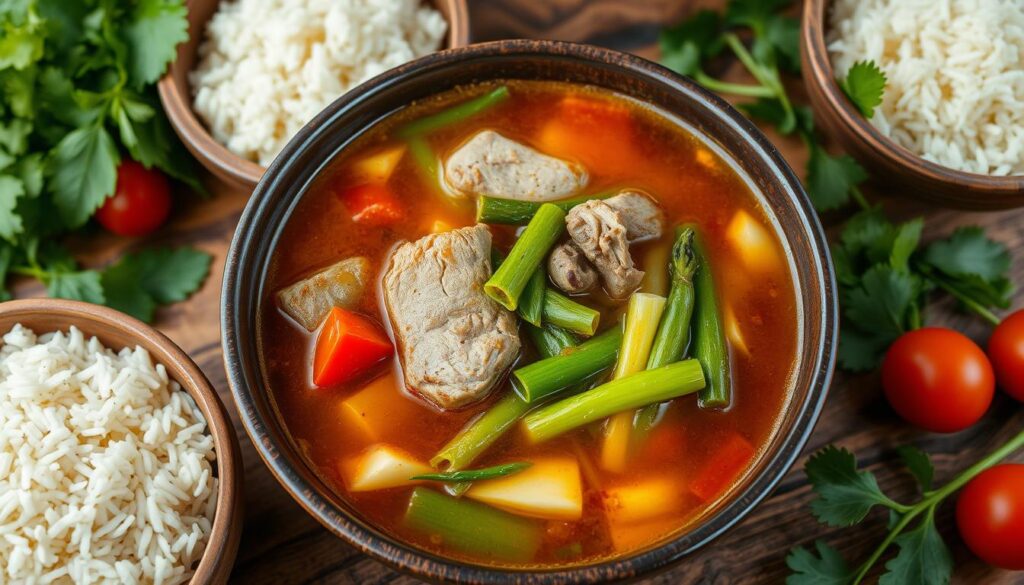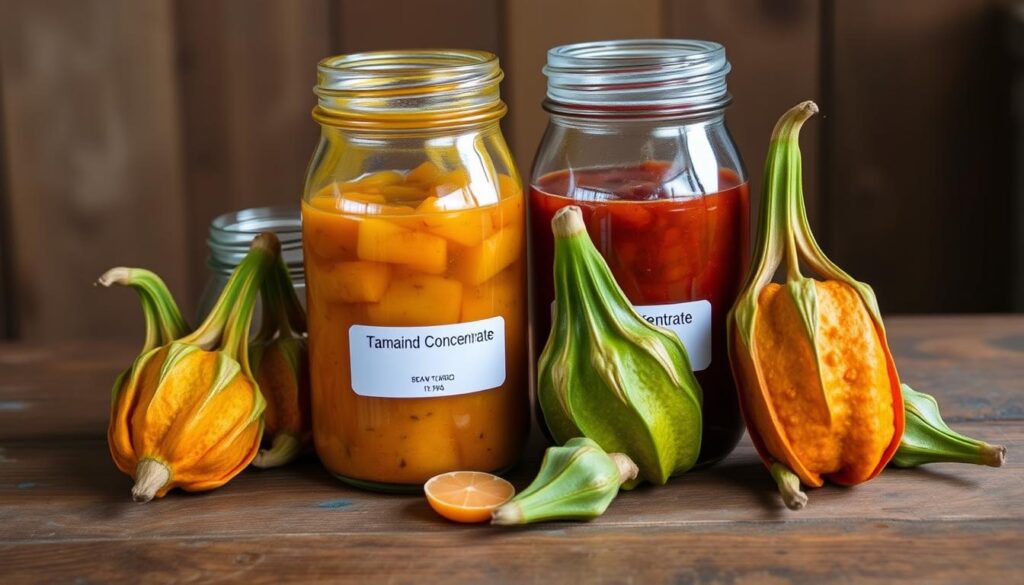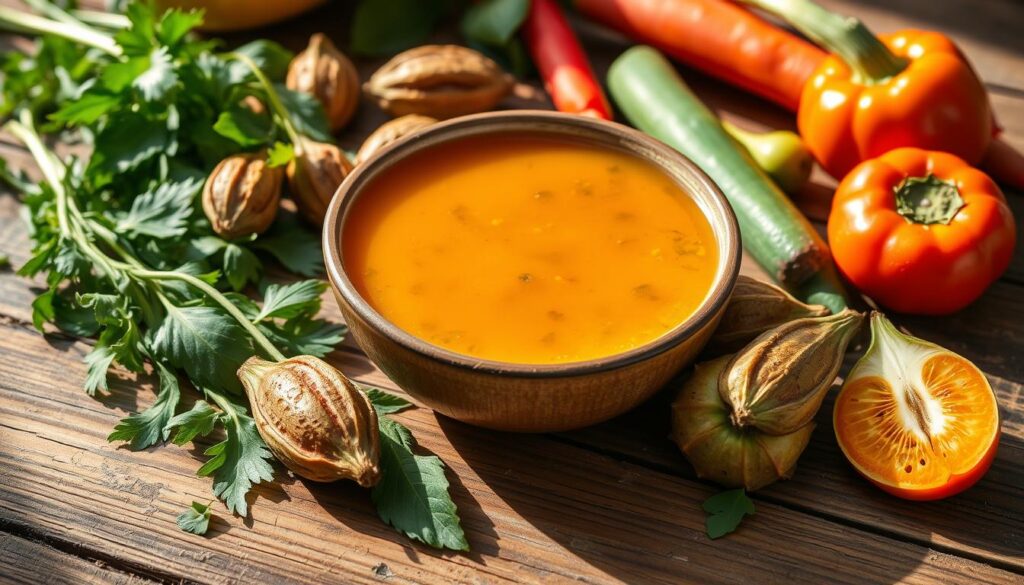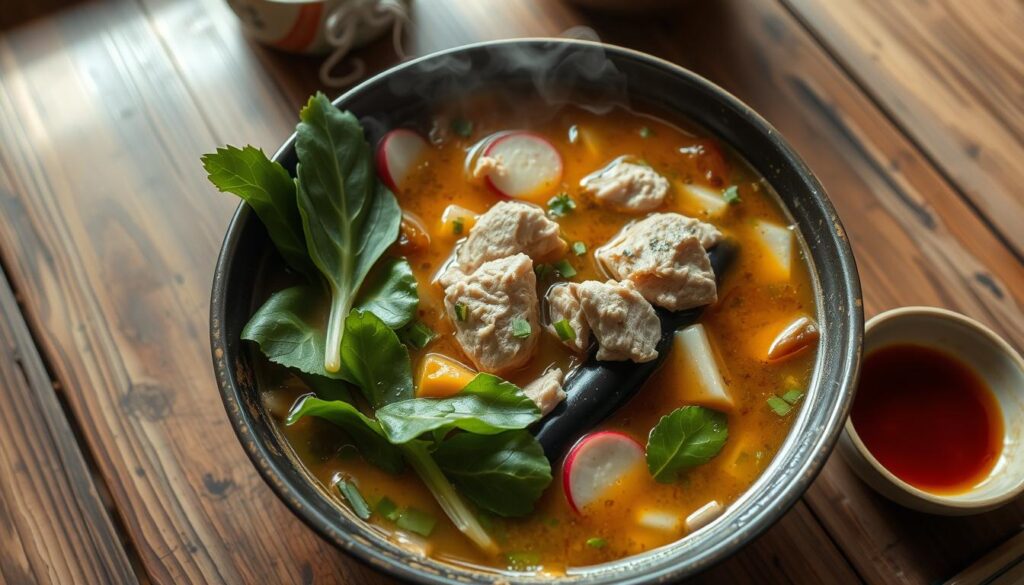The first time I tasted sinigang, it was a culinary revelation. The tangy broth was full of complex flavors. It took me to the vibrant kitchens of the Philippines. As a home cook, I often wonder about using tamarind concentrate in this beloved Filipino sour soup. Can I use tamarind concentrate in sinigang?
Sinigang is more than a meal; it’s a cultural experience. It connects generations with its unique sour taste. The secret to its flavor is the traditional souring agents, with tamarind being key. But can we use tamarind concentrate instead of fresh tamarind? This question has puzzled many cooks who want to make their cooking easier.
Key Takeaways
- Tamarind concentrate offers a convenient alternative to fresh tamarind
- Sinigang is a versatile Filipino soup adaptable to various dietary preferences
- The sourness is key to the authentic flavor of the dish
- Experimenting with souring agents can enhance your cooking skills
- Traditional recipes can be modified without losing cultural essence
Understanding Sinigang and Its Traditional Ingredients
I love exploring Filipino cuisine, and sinigang is a standout dish. It’s more than food; it’s a way to connect with family and culture.

What is Sinigang?
Sinigang is a beloved Filipino soup known for its sour and savory taste. TasteAtlas rates it as one of the world’s best soups, with a score of 4.63. It’s a true comfort food that highlights Filipino culinary traditions.
Common Ingredients Found in Sinigang
An authentic sinigang recipe uses a variety of ingredients for its complex flavors. The main ingredients are:
- Proteins: Pork, chicken, shrimp, or beef
- Vegetables:
- White radish
- Taro
- Chinese eggplant
- Leafy greens
- String beans
- Okra
- Seasonings: Fish sauce, garlic, onions, tomatoes
The Role of Tamarind in Authentic Recipes
Tamarind is key in sinigang, adding its sour taste. Chefs use different forms of tamarind, like:
| Tamarind Type | Characteristics |
|---|---|
| Whole Tamarind | Fresh pods with natural sourness |
| Tamarind Pulp | Concentrated flavor extract |
| Tamarind Concentrate | Convenient liquid form |
| Powdered Soup Base | Quick and easy preparation |
Pro tip: While other souring agents like calamansi or unripe mangoes are used, tamarind is the most traditional choice.
The Viability of Tamarind Concentrate in Sinigang
Preparing traditional Filipino sinigang with tamarind paste is a game-changer. The versatility of tamarind puree makes it a great substitute for fresh tamarind pods.
Benefits of Using Tamarind Concentrate
Tamarind paste offers several benefits for sinigang preparation:
- Consistent flavor profile
- Longer shelf life than fresh tamarind
- Quick and easy to use
- Eliminates seed removal process
I use about half a 14-ounce package of tamarind concentrate for a large pot. The key is diluting the paste with water to extract that signature sour flavor.
Differences Between Fresh Tamarind and Concentrate

Fresh tamarind gives an authentic taste, but tamarind substitutes like concentrate offer convenience. The concentrate lets you control the sourness level, making it easier to adjust the flavor.
“Tamarind paste transforms traditional cooking with its concentrated, tangy essence.”
Using tamarind paste has made my sinigang preparation easier. It shows that modern cooking techniques can improve traditional recipes without losing their authentic flavors.
How to Incorporate Tamarind Concentrate into My Sinigang
Making the perfect sinigang with tamarind concentrate needs skill and knowledge. I’ve found some important tips to boost your soup’s taste while keeping it true to tradition.

Mastering the Tamarind Concentrate Ratio
When adding tamarind paste to sinigang, being precise is key. For a 2-liter pot, about 3-4 tablespoons of tamarind concentrate is recommended. The right amount depends on how sour you like it:
- Mild sourness: Start with 2 tablespoons
- Medium tang: Use 3 tablespoons
- Intense flavor: Add 4 tablespoons
Flavor Balancing Techniques
To mix tamarind concentrate well into sinigang, follow some steps. I mix the concentrate with warm water first, then add it to the pot. This spreads the flavor evenly.
“The key to perfect sinigang is balancing sourness with depth of flavor.” – Filipino Culinary Tradition
| Ingredient | Quantity | Purpose |
|---|---|---|
| Tamarind Concentrate | 3-4 tablespoons | Primary souring agent |
| Water | 1/2 cup | Dilution medium |
| Fish Sauce | 2 tablespoons | Flavor enhancement |
For the best sinigang with tamarind concentrate, add the mix after sautéing the aromatics. But before adding veggies and proteins. Let it simmer to blend the flavors well.
Potential Health Benefits of Tamarind Concentrate
Tamarind is a nutritional powerhouse with health-boosting properties. It’s a key ingredient in sinigang, adding flavor and health benefits. Research shows it’s an excellent addition to your diet.

The health benefits of tamarind go beyond its taste. Let’s explore its impressive nutritional profile:
Nutritional Powerhouse of Tamarind
- Contains high levels of antioxidants that combat cellular damage
- Provides over 25% of daily magnesium requirements
- Rich in polyphenols with anti-inflammatory properties
- Low glycemic index beneficial for diabetes management
Impressive Nutritional Breakdown
A 100-gram serving of tamarind is packed with nutrients:
- 13% recommended daily potassium
- 23% magnesium
- 35% iron
- 36% thiamin (Vitamin B1)
- 12% niacin (Vitamin B3)
- 2.8 grams of protein
“Tamarind is not just a flavor enhancer, but a nutritional treasure trove waiting to be explored in your kitchen.”
In sinigang, tamarind concentrate adds tangy flavor and health benefits. It boosts the nutritional value of sinigang, making it more than a comforting meal.
Potential Health Advantages
Research suggests tamarind may support:
- Cardiovascular health
- Inflammation reduction
- Blood sugar regulation
- Digestive wellness
Adding tamarind concentrate to your sinigang is more than just cooking. It’s a way to support your health in many ways.
Conclusion: My Experience with Tamarind Concentrate in Sinigang
My journey with sinigang has been a fun culinary adventure. Using tamarind concentrate made this traditional Filipino soup easy to make and always flavorful. Even though fresh tamarind is key in real recipes, the concentrate is a great substitute.
While cooking, I found that tamarind concentrate lets you control the sourness. It works well in all sinigang types, from pork to seafood to vegetarian. The trick is to balance the flavors right.
Trying out different ingredients has shown me that cooking is all about being creative. I’ve tried different pork cuts and added fish sauce to see what works best. My advice is to enjoy the process and don’t be afraid to change up recipes.
If you’re new to cooking with tamarind concentrate, give it a try. Start with small changes and taste as you go. Sinigang is a dish that loves new ideas but also respects its roots.




2 thoughts on “Can I Use Tamarind Concentrate in Sinigang?”